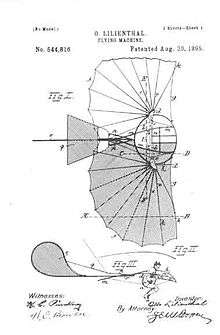Lilienthal Normalsegelapparat
| Normalsegelapparat | |
|---|---|
 | |
| Lichterfelde (near Berlin), 29 June 1895 | |
| Role | Glider |
| National origin | Germany |
| Manufacturer | Otto Lilienthal |
| Designer | Otto Lilienthal |
| First flight | 1893 |
|
| |
The Lilienthal Normalsegelapparat ( German: "Normal soaring apparatus") is a glider designed by Otto Lilienthal in Germany in the late 19th century. It is considered to be the first aeroplane to be serially produced, examples being made between 1893 and 1896.
Nine examples are known to have been sold, the buyers including Nikolai Zhukovsky and William Randolph Hearst. Three original "normal gliders" are preserved in museums in (London, Moscow, and Washington[1]), and a fragment of one is preserved in Munich. A similar glider, the Sturmflügelapparat ("storm wing apparatus") is preserved in the Technisches Museum in Vienna.
Lilienthal's flights using this glider typically achieved a distance of 250 m (820 ft) starting from the top of the launching mound that he had constructed. A bow frame or "Prellbügel" was used to reduce the impact in case of a crash. Later the Normalsegelapparat was developed into a biplane.
Specifications (typical)

Data from
General characteristics
- Crew: One
- Length: 5.30 m (17 ft 5 in)
- Wingspan: 6.70 m (22 ft 0 in)
- Wing area: 13.6 m2 (146 sq ft)
- Empty weight: 20 kg (44 lb)
Performance
- Maximum glide ratio: 5
References
- ↑ John R. Dailey; John H. Glenn, Jr. Smithsonian National Air and Space Museum: An Autobiography. p. 46.
- ↑ US Patent No. 544816